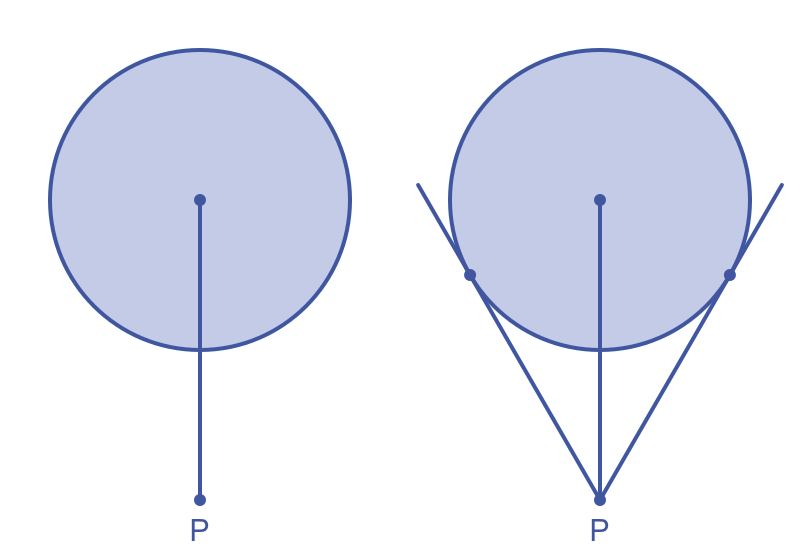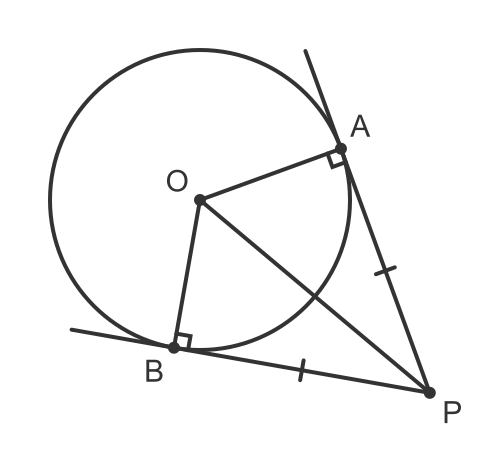Two tangents from a point have equal length
Categories: gcse geometry
Level:

A tangent is a line that just touches the circle at a single point on its circumference.
If we take any point P outside the circle, we can draw two tangents. Those two tangents will have equal lengths.

This means that the length PA and the length PB will always be equal.
Here is a video on the topic:
Intuitive argument
We can use symmetry to provide an intuitive argument as to why this might be true.

The diagram on left shows a circle with a point P directly below it. This diagram is symmetrical - the left and right halves are identical mirror images of each other.
We then draw two tangents (diagram on the right).
Due to symmetry, there is no reason to assume that one tangent should be longer than the other. Intuitively it seems reasonable to assume that the two tangents are equal.
This is not a proof, but it indicates that the tangents are probably equal. The proof is given next.
Proof
You aren't required to learn this proof for GCSE, it is just here for information.
We want to prove that PA and PB are equal.
We will prove this by proving that triangles OPA and OPB are congruent:

We will use three facts to prove that the triangles are congruent.
- They are both right-angled triangles. For the triangle OPA, the side OA is a radius and the side PA is a tangent. The tangent and radius circle theorem tells us that a radius and tangent meet at 90°, so the angle at A is 90°. The same is true for the triangle OPB and the angle at B is also 90°.
- Both hypotenuses are the same. The two triangles share a hypotenuse, the line OP, so they have to be equal in length.
- The two triangles also have a side of the same length. The side OA of triangle OPA is a radius. The side OB of triangle OPB is also a radius. So both triangles have an equal side.
According to the RHS rule of congruent triangles, two right-angled triangles where the hypotenuse is equal and any side is equal are congruent.
This means that the third side of each of the two triangles are equal, PA equals PB, which is what we set out to prove.
Related articles
- Parts of a circle
- Perpendicular bisector of chord theorem
- Angle at the centre of a circle is twice the angle at the circumference
- Angle in a semicircle is 90°
- Angles in the same segment of a circle are equal
- Opposite angles in a cyclic quadrilateral add up to 180°
- Tangent and radius of a circle meet at 90°
- Alternate segment theorem
- Two radii form an isosceles triangle
Join the GraphicMaths Newsletter
Sign up using this form to receive an email when new content is added to the graphpicmaths or pythoninformer websites:

Popular tags
adder adjacency matrix alu and gate angle answers area argand diagram binary maths cardioid cartesian equation chain rule chord circle cofactor combinations complex modulus complex numbers complex polygon complex power complex root cosh cosine cosine rule countable cpu cube decagon demorgans law derivative determinant diagonal directrix dodecagon e eigenvalue eigenvector ellipse equilateral triangle erf function euclid euler eulers formula eulers identity exercises exponent exponential exterior angle first principles flip-flop focus gabriels horn galileo gamma function gaussian distribution gradient graph hendecagon heptagon heron hexagon hilbert horizontal hyperbola hyperbolic function hyperbolic functions infinity integration integration by parts integration by substitution interior angle inverse function inverse hyperbolic function inverse matrix irrational irrational number irregular polygon isomorphic graph isosceles trapezium isosceles triangle kite koch curve l system lhopitals rule limit line integral locus logarithm maclaurin series major axis matrix matrix algebra mean minor axis n choose r nand gate net newton raphson method nonagon nor gate normal normal distribution not gate octagon or gate parabola parallelogram parametric equation pentagon perimeter permutation matrix permutations pi pi function polar coordinates polynomial power probability probability distribution product rule proof pythagoras proof quadrilateral questions quotient rule radians radius rectangle regular polygon rhombus root sech segment set set-reset flip-flop simpsons rule sine sine rule sinh slope sloping lines solving equations solving triangles square square root squeeze theorem standard curves standard deviation star polygon statistics straight line graphs surface of revolution symmetry tangent tanh transformation transformations translation trapezium triangle turtle graphics uncountable variance vertical volume volume of revolution xnor gate xor gate